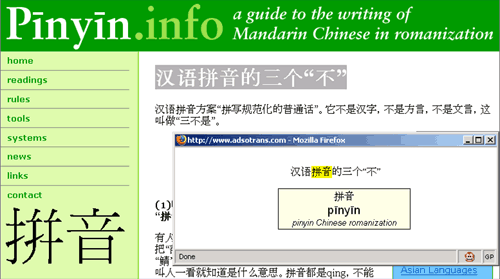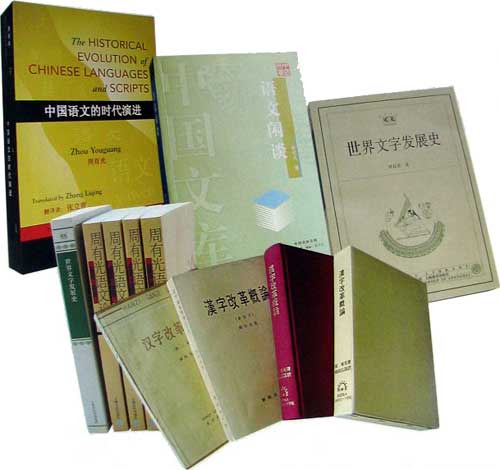Although my favorite Web browser remains Opera (which is now free), I recognize that Firefox (which has always been free) has some nice things going for it, especially its wide range of extensions.
At least two of these extensions might be of special interest to readers of this site: Translate, which will translate a Web page from Mandarin Chinese (as well as lots of other languages) into English (more or less), and the Adso GreaseMonkey Script, which provides Pinyin and English annotation for Chinese characters.
First, Translate, which is the cat’s pajamas. I don’t know how I survived without it.
- Using Firefox, Install Translate. (If that link has expired, find the installation through the home page of Gravelog.)
- Firefox will likely block your installation at first, which is a good thing. (Safety first.)
- Look for this message in a bar near the top of your browser window: “To protect your computer, Firefox prevented this site (ctomer.com) from installing software on your computer.”
- Click on the “Edit Options” button in the same bar (near the top right of your screen).
- A pop-up box will appear. Click on “Allow” and then “Close”.
Restart Firefox.
Try out the extension by going to a Web page with text in Chinese characters.
From the Firefox menu, choose Tools --> Translate --> Translate from Chinese-simp[lified] (or Tools --> Translate --> Translate from Chinese-trad[itional], as appropriate). The translated Web page will appear in a few moments.
If you want to translate just a portion of the text on a Web page, or if Babel Fish chokes on the text of the entire Web page and you need an alternate approach, simply use your mouse to select the text you’re interested in. Next, right click and select Translate --> From Chinese-simp (or Translate --> From Chinese-trad , as appropriate). Note: The translation will appear in a new tab, so don’t sit around waiting for the translation to appear in the same tab you’ve been working in.
Translate also handles Japanese, Korean, French, German, Spanish, Italian, Dutch, Portuguese, Greek, and Russian.
A related but less effective extension is gtranslate, which handles limited amounts of text in simplified but not traditional characters.
Now let’s examine the Adso GreaseMonkey Script.
- Install Firefox or upgrade to version 1.5.
- Using Firefox, install Greasemonkey (If that link has expired, find the installation through the main Greasemonkey page.)
- Firefox will likely block your installation at first, which is a good thing. (Safety first.)
- Look for this message in a bar near the top of your browser window: “To protect your computer, Firefox prevented this site (greasemonkey.mozdev.org) from installing software on your computer.”
- Click on the “Edit Options” button in the same bar (near the top right of your screen).
- A pop-up box will appear. Click on “Allow” and then “Close”.
- Restart Firefox.
- Install the Adso GreaseMonkey Script.
- Look for this message in a bar near the top of your browser window: “This is a Greasemonkey user script. Click Install to start using it.”
- Click the “Install” button in the same bar (near the top right of your screen).
Try it out by going to a Web page with text in Chinese characters.
To activate the script, press “a”.
Click on or highlight the script you’re interested in seeing the Pinyin for.
Move your mouse over the Chinese characters in the pop-up box; the Pinyin will appear.

To deactivate the script, press any other key.
For more information, see the Firefox Plugin: Chinese text annotation thread on Chinese-forums.com.
Of related interest is the Rikai Web page converter.

 Friday, January 13, is Zhou Youguang’s 101st birthday. Zhou is one of the main people behind the creation of
Friday, January 13, is Zhou Youguang’s 101st birthday. Zhou is one of the main people behind the creation of 
